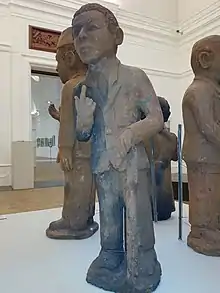Noria Mabasa
Noria Muelwa Mabasa (née Luvhimbi) (born 1938, Shigalo (Xigalo), Malamulele, South Africa) is a Tsonga artist, who works primarily in ceramic and wood sculpture.[1]
Noria Mabasa | |
|---|---|
| Born | May 10, 1938 Xigalo, Limpopo Province, South Africa |
| Nationality | South African |
Early life
Noria Mabasa was born Noria Muelelwa Luvhimbi on May 10th, 1938 in Shigalo village, Limpopo.[1] She was the third child born in her family with two older sisters. [2] In 1955, she married Jim Mabasa who was from Ha-Mutsha village, Limpopo. She separated from Jim Mabasa in 1965 after she fell ill with a mysterious illness. He was impatient with her and ordered her to leave his home. She went back to Shigalo village.[3]
Completely self-taught, Mabasa currently resides at the Tshino village in the Vuwani area of Venda, where she runs an art school in which she instructs her students in the art of clay-pot and sculpture making. She began working with clay in 1974 and two years later, in 1976, she became the first Tsonga woman to work in wood. She received local training.[4]
Career

Noria Mabasa completed one year of formal education at a school located three hours walking distance from her childhood home, but had to discontinue schooling in lieu of household chores. In 1965 she began having recurring dreams of an old woman who showed her how to work in the clay medium, and prompted her to receive local training on the traditional craft.[5] Her first clay figures were often small and were often given away to local children. She continues to create work inspired by the messages and visions of her dreams.
Mabasa has working as an artist since 1976. She was encouraged to begin woodcarving after the suggestion of Venda sculptor Nelson Mukhuba in 1983. Her earliest figures were modeled after clay and wood matano figures used in domba initiation ceremonies. Mabasa initially found recognition on both the national and international art scenes in the 1980s with her ceramic figures painted with enamel paint. Her naturalistic figures are coil-built and fired in an open straw fire. Her current work combines the figurative and the functional; pots often take the shape of the female figure or feature faces.[6]
Works
Mabasa's works deal mostly with traditional issues, particularly those pertaining to women, as well as subjects of Venda mythology and spirituality. She mainly works with clay from her local river bank and wood for her art pieces.[2] Mabasa's work focuses on access to education, as well as gendered-based violence.
- Her wooden sculpture named The Flood (1994) took her nine months to create. The entire sculpture is made out of a fig tree trunk. She wanted to depict the devastation of floods on local villages. It is currently displayed in the foyer of the Sandton Convention Center in Johannesburg.[2]
- Her famous work of The Drum of Thunder follows the story of the Singo people and their mystical drum.[2] It sold for 150,000 South African Rand (8,598.66 USD) during an auction in 2017.[7]
- Union Buildings (1999) is another of her famous works.
Currently, Mabasa has a functioning gallery in her home of Tshino Village, located just outside the city of Thohoyandou . [4]
Sources
- Arnold, Marion and Brenda Schmahmann. Between Union and Liberation: Women Artists in South Africa 1910–1990. Burlington, VT: Ashgate, 2005.
- Visonà, Monica B., Robin Poynor, and Herbert M. Cole. A History of Art in Africa. 2nd Ed. New York: Harry N. Abrams, 2001.
Bibliography
Perryer, Sophie (2004). 10 Years 100 Artists: Art In A Democratic South Africa. Cape Town: Struik. ISBN 1868729877.
References
- sahoboss (17 February 2011). "Noria Mabasa". South African History Online. Retrieved 3 March 2019.
- Press, Karen (2003). Noria Mabasa. Johannesburg, South Africa: David Krut Pub. : Thorold's Africana Books [distributor]. ISBN 0958449651.
- iano82. "Vhavenda". Luonde. Retrieved 5 August 2020.
- Makana, Chester (22 March 2018). "Noria Mabasa's sculptures tackle gender based violence". News24. Retrieved 3 March 2020.
- "Noria Mabasa | Gallery 181". www.mukondeni.com. Retrieved 3 March 2019.
- Pike, Charles Ben; Younge, Gavin (August 1989). "Art of the South African Townships". African Arts. 22 (4): 83. doi:10.2307/3336676. ISSN 0001-9933. JSTOR 3336676.
- "User account | NewsBank". infoweb.newsbank.com. Retrieved 18 August 2020.